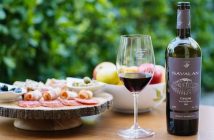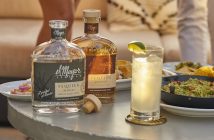Sophie embarks on an oenologist’s paradise, touring Argentina’s fabled wine country…
“Revancha!!” the commentator shouts. Strong in his accent. It is the eighth chukka. The final one of the day and the last one of the Hurlingham Cup overall. A player fallen from his pony seconds earlier lies on the ground motionless. His livery reads ‘Stirling’: Number 2. He is one of the six ten-goal players across today’s two teams – an impressive handicap from an altogether remarkable line-up. Today it is La Dolfina vs Elestrina. La Dolfina is currently in the lead 18-14 with only 01:19 minutes left on the clock. They are captained by Adolfo Cambiaso – a man with power and finesse; widely reported as the world’s current greatest player. In front of me to my left sits the British Ambassador in a Panama hat and linen suit. The crowd sits spectating with silenced beating hearts. In a flash the fallen player is back on his pony, as if he’d never come off at all.
Amidst the match tension under the brilliant sunshine I meet ‘Pepe’, current president of the Hurlingham Club, a one-time polo player himself who in 1999 famously played here with Prince Charles. We talk about Argentina. We talk about wine. He tells me he has a winery in Salta. An estate set at 2,100m where he grows three varietals to make a Torrontes and a Malbec/Tannat. “It’s like being on the moon,” he says.
The next day I understand completely what he means. 1500km north-west of Buenos Aires we find ourselves in a landscape reminiscent of Death Valley. Except this place, as much as it is dry, painted in reds, violets and oranges from the iron, copper and magnesium-rich, oxidised soils, is also fecund; full of bright green vegetation that sits in stark contrast to the rest of surrounding colours and naked blue skies. Brea trees and tobacco plants dominate our panoramic drive through the Calchaquíes Valleys – a fluorescence that is quickly replaced with rows and rows of vines once we reach Cafayate. Here, against the backdrop of the magnificent Andes Mountains, dusty travellers are rewarded with glasses full of bright, saliva-inducing, fresh, fruity wine.
Poolside, at the stunning Patios de Cafayate Wine Hotel, we meet Alejandro – winemaker at Bodegas El Esteco. From the lookout at the top of the winery we’re able to see the neatly angled vines from which they get their fruit. This is an old winery, built in 1822, now owned by one of the bigger wine corporations in Argentina. But the intimate feel remains, alongside the undeniable passion that still inhabits the wines that we taste. The range, aside from Malbec, includes Chardonnay, Sauvignon Blanc, Pinot Noir and Cabernet Sauvignon – full of fine tannins, bright acidity and elegance that so identifies this region in terms of style. This quality and elegance is just as clearly marked in what is bottled at neighbouring winery El Porvenir (‘The Coming’), under the guise of 33 year-old winemaker Mariano Quiroga. It’s only in the last fifteen years that the wine scene here has exploded, led perhaps by people like Bordeaux’ Michel Rolland, or much-revered Donald Hess from California. Recent huge development is happening, notable from the opening of other wineries such as American-owned Piatelli whose Disney-like investment in the latest winemaking equipment is second-to-none.
Further south over dinner at Mendoza’s Siete Cocinas, a restaurant whose aim is to offer its diners cuisine inspired by Argentina’s seven regions, I meet Juan. Juan is one youthful half of the Michellini brothers who own and run Zorzal Wines and is an example of how Argentina’s wine industry v 2.0 is growing. Like at Piatelli, Juan has recently started to use concrete eggs, the latest in winemaking gadgets that help produce wines with a richer texture and flavour. His Eggo Blanc, an aged Sauvignon made in this way, is out of this world: the dynamism translates.
Another man with just as much energy is Cristian Reich, a young, Chilean engineer who spent time working with the Australian Navy in Sydney before moving back to Mendoza to take over family-run operations at Bodegas Renacer. Renacer means rebirth – and here they’re certainly sticking to their ethos. Argentineans, mindful of their continually chequered economic history, have a great resilience to their ever changing state of affairs. Theirs is a forward thinking attitude and a heart full of determination to succeed at whatever comes next. Caroline from Bodegas Tapiz echoes this when we meet around the lunch table in Renacer’s beautiful Italian-styled grounds. She tells me of her interestingly varied past career that includes being an airhostess for Air France. “We’re used to starting over”.
The wine industry in Argentina first began in 1551 when vitis vinifera was introduced via Chile by Spanish colonists. From the 1900s to the 1970s there was no need to export the wines – they were barely able to produce enough for the domestic market when consumption back then was a whopping 90L per person per year. Today this has decreased to 25.6L. Tastes and trends have changed, from the original concept of wine and water, and wine with water. We are invited to a reminder of these previous ways after dinner at long-reigning producers Luigi Bosca, roaming home in search of ‘choripan’ after a few final Fernet Branca digestifs in town.
It is late, and this is tradition. Crusty bread rolls stuffed with chorizo land in their greasy papers in front of us. We’re sitting on plastic benches. Dogs sniff at our feet while we wrestle with the mayonnaise that oozes out of our sought-out late night snacks. We order soda water from the attending ‘don’t mess with me’ canteen ladies who have probably worked here all their lives. The soda arrives in two large glass bottles, not unlike the ones that decorate the San Telmo market stalls in Buenos Aires every Sunday. We add it as a topper to our plastic cups of Malbec, as one-time Argentine convention dictates. Chatter from grimy, smile-filled faces now fills the early morning air.
In contrast to our previous night’s affairs, we witness a much sleeker side to the wine world the next day in the UCO Valley. 90km from Mendoza, this area is known for its ‘cool’ climate as well as being an apt descriptor for its current reputation. At Bodegas O’Fournier our minds are blown by both the wines and the overall winery design – a space that could very easily be cast in the next James Bond movie. The same goes for Salentein, a winery designed by the same Dutch architects – featuring a huge compass on the barrel room floor. Here today there also sits a Grand Piano, and as fortune would have it, we are in the company of a talented pianist. In this natural amphitheatre we pause to a background of Beethoven’s 29th Sonata, ageing us and the wines slowly with a little more grace and charm.
Our final night in Mendoza is spent in the company of more humbling people and their brilliant new wines. We are at Mendel, and we meet industry ‘godfather’ Roberto de la Mota. Whilst tasting, it can’t help be noticed that Roberto is in a wheelchair, the result of a near fatal car accident a few years ago. Yet this doesn’t stop him tending to his wines with just as much attention as before. It is a poignant ending to our time here. But harmonious still. Like the player who fell off his pony on our second day, people here come back fighting. And in a story that now comes full-circle, we’re told the name of Roberto’s new project: ‘Revancha’.
Many of the producers Sophie mentions will feature at the London Wine Fair, which runs at Kensington Olympia from 18th – 20th May 2015. For more information, visit www.londonwinefair.com.




